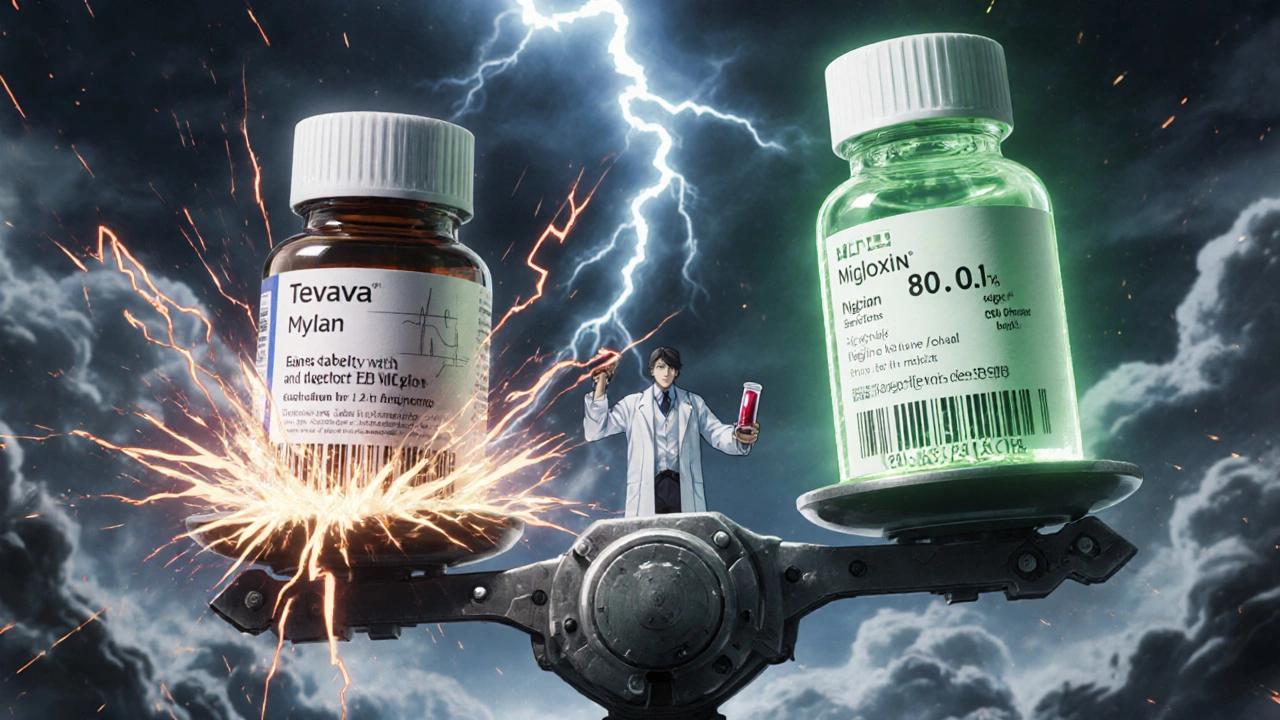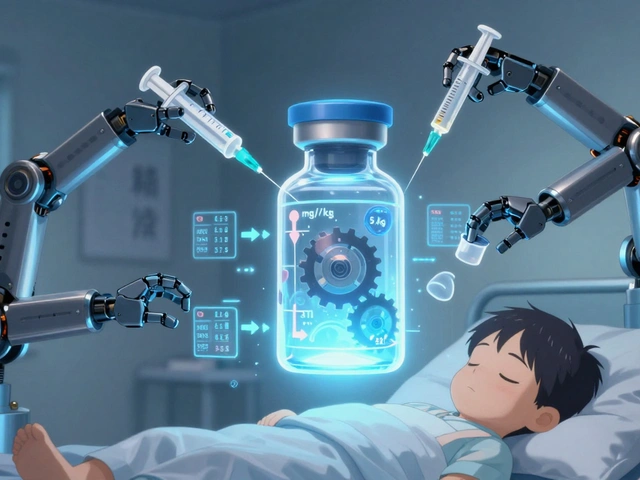Why Digoxin Isn’t Like Other Generic Drugs
Most people assume a generic drug is just a cheaper version of the brand-name pill - same active ingredient, same effect. But with digoxin, that assumption can be dangerous. Digoxin is a heart medication used for atrial fibrillation and heart failure. It’s not just any drug. It’s a narrow therapeutic index (NTI) drug, meaning the difference between a helpful dose and a toxic one is tiny. The safe range? Between 0.5 and 2.0 nanograms per milliliter in the blood. Go a little over, and you risk vomiting, confusion, irregular heartbeat - even death. Go a little under, and your heart condition worsens. That’s why switching between generic digoxin brands isn’t like switching from one brand of aspirin to another.
What Bioavailability Really Means for Digoxin
Bioavailability is how much of the drug actually gets into your bloodstream after you swallow it. For most drugs, a 20% variation between brand and generic is fine. For digoxin? It’s not. The FDA requires generic digoxin to match the brand-name drug (Lanoxin) within 80-125% for both total exposure (AUC) and peak concentration (Cmax). On paper, that sounds strict enough. But here’s the catch: those numbers are averages across a group of healthy volunteers. One person might absorb only 45% of the drug. Another might absorb 95%. The average could still meet FDA standards - but that one person who absorbs too little? They’re at risk of heart failure getting worse. The one who absorbs too much? They could end up in the ER with a dangerous arrhythmia.
Generic Switches Can Be Risky - Even If They’re "Bioequivalent"
The FDA lists three generic digoxin tablets with an "AB" rating, meaning they’ve passed bioequivalence tests. Sounds safe, right? Not quite. Those tests only compare each generic to Lanoxin. They don’t compare one generic to another. So if you’re on one generic brand - say, from Teva - and your pharmacy switches you to another - say, from Mylan - you’re moving from one unknown to another. There’s no data showing those two generics behave the same in your body. Real-world cases show serum digoxin levels can shift by more than 25% after switching between generics. That’s enough to cause toxicity or treatment failure. Elderly patients, who make up most digoxin users, are especially vulnerable. Their kidneys clear the drug slower. Their bodies absorb it differently. One small change in absorption can throw their whole balance off.

Formulation Matters More Than You Realize
Not all digoxin pills are made the same. Even within the same manufacturer, changes in fillers, binders, or coating can affect how quickly the drug dissolves. And it’s not just tablets. Digoxin elixir (liquid form) is absorbed much better - 70% to 85% of the dose gets into the blood, compared to about 60-80% for tablets. If a patient switches from tablet to liquid - or vice versa - without adjusting the dose, the effect can be dramatic. A dose that was safe in tablet form might become toxic in liquid form. That’s why doctors need to know exactly what formulation a patient is taking, down to the manufacturer and form (tablet, capsule, elixir).
When and How to Monitor Digoxin Levels
There’s no way around it: if you’re on digoxin, you need regular blood tests. The American College of Clinical Pharmacy recommends checking serum levels just before your next dose - that’s the "trough" level. For most patients, aim for 0.5-0.9 ng/mL, not the old upper limit of 2.0. Newer studies show lower levels reduce death risk in heart failure patients without losing benefit. You should get your first test 4-7 days after starting digoxin or changing your dose. After that, check it whenever your kidney function changes, you start a new medication (like antibiotics or diuretics), or your symptoms shift. And if you switch generic brands? Test again 3-5 days later. That’s not optional. That’s how you catch problems before they become emergencies.

What Clinicians Should Do - And What Patients Should Ask For
Doctors should avoid switching digoxin products unless absolutely necessary. If a switch happens - because of cost, insurance, or pharmacy stock - they need to treat it like a new prescription. Check the level. Watch for symptoms. Don’t assume "it’s the same drug." Patients should know their exact digoxin product: brand name, generic manufacturer, and form (tablet or liquid). Write it down. Bring it to every appointment. If your pharmacy switches your pill without telling you, ask why. Demand a level check after any change. You’re not being difficult - you’re protecting your heart.
Why This Matters Beyond Digoxin
Digoxin isn’t alone. Other NTI drugs - like warfarin, lithium, phenytoin, and tacrolimus - have the same risks. But digoxin is one of the most common. It’s cheap, old, and widely used. That’s why it’s often treated like an afterthought. But its narrow window makes it one of the most dangerous generics to switch without oversight. The fact that the FDA treats digoxin as a "new drug" for generic approval - not just another copy - tells you everything you need to know. It’s not just about money. It’s about survival.
Bottom Line: Consistency Saves Lives
If you’re on digoxin, stick with the same product - brand or generic - as long as possible. Don’t let a pharmacy change it without your knowledge. If a switch happens, get your blood tested within a week. Know your numbers. Know your symptoms. And never assume two generics are the same just because they’re both labeled "digoxin." Your heart doesn’t care about pharmacy savings. It only cares about the right dose - and that’s not always easy to guarantee with generics.
Can I switch between different generic digoxin brands safely?
No, not without monitoring. Even if each generic meets FDA bioequivalence standards individually, there’s no data proving they behave the same when switched between each other. Serum levels can shift by over 25% after switching manufacturers, leading to toxicity or treatment failure. Always check your digoxin blood level 3-5 days after switching.
What are the signs of digoxin toxicity?
Symptoms include nausea, vomiting, loss of appetite, blurred or yellow-green vision, confusion, dizziness, and irregular heartbeat - especially slow or skipped beats. In older adults, these signs can be mistaken for aging or dementia. If you’re on digoxin and notice any of these, contact your doctor immediately and request a blood test.
Is digoxin elixir better than tablets?
It’s not necessarily better - but it’s more predictable. Digoxin liquid is absorbed at 70-85% of the intravenous dose, while tablets vary between 60-80%. That means the liquid form gives more consistent blood levels, especially in patients with swallowing issues or stomach problems. But if you switch from tablet to liquid, your dose must be adjusted - never assume they’re interchangeable without testing.
How often should digoxin levels be checked?
Check at least once when starting therapy or changing dose - wait 4-7 days for steady levels. Then, recheck after any change in kidney function, new medications (like antibiotics or diuretics), or if symptoms change. After switching generic brands, test again in 3-5 days. For stable patients on the same product, annual checks may be enough - but only if kidney function is normal and no other changes occur.
Why does the FDA treat digoxin differently from other generics?
Because digoxin has a narrow therapeutic index - a tiny difference in dose can cause harm. The FDA requires stricter bioequivalence testing than for most drugs. Generic digoxin must meet 80-125% bioequivalence for both absorption and peak levels, and manufacturers must prove batch-to-batch consistency. It’s one of the few generics classified as a "new drug" for approval, reflecting its unique risks.







Pawan Jamwal
November 21, 2025 AT 10:41This is why India's generic pharma is the best in the world! 🇮🇳 We make digoxin cheaper AND better. No Western panic needed. Your body adapts. Stop overthinking. 🚀
Bill Camp
November 21, 2025 AT 19:46I can't believe this is even a debate. I had a cousin die from a generic digoxin switch. They didn't even tell her they changed the pill. She thought she was fine until she started seeing halos around lights. That's not medicine. That's Russian roulette with a heart. 💔
Lemmy Coco
November 23, 2025 AT 18:00i just found out my pharmacy switched my digoxin last week and i didnt even notice… i think i might be having weird dizziness? should i get it checked? i dont wanna be a drama queen but… idk anymore
rob lafata
November 24, 2025 AT 08:25Let me break this down for the clueless: The FDA doesn't give a flying fuck about your safety. They care about corporate profits. Generic manufacturers game the bioequivalence tests like it's a fucking video game. They tweak fillers, use different binders, and then slap an AB rating on it like it's a stamp of approval. You think your kidney clears digoxin the same as a 25-year-old lab rat? LOL. You're a walking toxicity waiting to happen. And no, your 'stable' level doesn't mean shit if your pharmacy swapped your pills without telling you. You're not a patient. You're a lab rat in a suit. 🧪
Matthew McCraney
November 25, 2025 AT 12:29This is all part of the Big Pharma cartel. They let the generics in so they can control the supply chain. Then they switch your pill to make you dependent on their labs for monitoring. The government knows. The doctors know. But they're all paid off. I checked my pill markings and they changed from 'D 50' to 'D 51' - that's not a coincidence. That's mind control. I'm switching to herbal remedies. Digitalis purpurea is way safer. No FDA. No corporations. Just nature. 🌿
serge jane
November 27, 2025 AT 07:30The real issue here isn't the generic vs brand debate it's the entire model of how we treat chronic illness as a transaction rather than a relationship between person and medicine we treat people like data points and pills like interchangeable parts but the body doesn't work that way digoxin is not a light switch it's a tuning fork and if you change the material it changes the frequency and the heart doesn't know how to adapt it just stops or goes haywire and we call that patient noncompliance when really it's the system that's broken
Nick Naylor
November 28, 2025 AT 03:05The FDA's 80-125% bioequivalence window for digoxin is a catastrophic failure of regulatory oversight. The pharmacokinetic variance in elderly populations with renal impairment is not accounted for in cohort-based trials. Furthermore, the absence of cross-comparative bioequivalence data between generic manufacturers constitutes a systemic blind spot in post-marketing surveillance. This is not pharmacology. This is pharmaceutical roulette. And the cost of failure? Mortality. 🚨
Brianna Groleau
November 28, 2025 AT 05:17I'm a nurse in a senior center and I see this every week. An elderly lady comes in, says she feels 'off' - tired, nauseous, confused. We check her meds - she was switched from Teva to Mylan last month. No one told her. No one checked her levels. She thought it was just 'getting old.' We tested her - digoxin was at 2.8. She was one step from cardiac arrest. We switched her back. She cried. Said she didn't know she had to fight for her own medicine. I just wish more people knew: your heart doesn't care what the label says. It only cares if the dose is right. And sometimes, that means asking questions. Even if you're scared. Even if you feel like a bother. You're not. You're the most important part of this whole system.